American jet aircraft Bell P-59A Airacomet
At the end of the 1930-s, American designers conducted rather “sluggish” experiments with combined moto-oppressive installations. The result of the data was a unit based on a piston engine combined with an axial compressor. However, he was never put on a plane because of too much weight, bulkiness and too much fuel consumption.
In order to somehow make up for lost time, the Americans turned to the overseas experience. Assistance was provided by England providing drawings, technical documentation and several prototypes of Whitle’s turbojet engines. Under these engines immediately began to design the aircraft, which received the designation XP-59.
The original XP-59 designation was assigned to Bell's 16 model, a two-beam fighter with piston engines and pusher coaxial screws. But in December 1941, the US Air Force refused to build this option, and subsequently the number "59" passed to the first jet aircraft of the company. Although this plane was the first car equipped with turbojet engines that rose into the air (the Germans and the British deserved the palm), Bell P-59, unlike its predecessors, was originally designed as a combat fighter for the finished engine. But first things first.
The creation of aircraft has always been associated with mystery. In addition to the fact that for the aircraft being created, an index was left that previously belonged to a piston machine, the work was carried out in the strictest secrecy. Designers who participated in the project were isolated from the rest of Bell employees and were placed not in the design bureau, but in Buffalo in the building on Elnwood Avenue (owned by Pierce Arrow). The prototype began to troit in one of the institutions, also leased from Ford. It was from this building that had the first XP-59А rolled out in September, 1942, with painted glass and barred windows.
American jet aircraft began its history in April, 1941, when Major General G. Arnold, who led the US Air Force during World War II, visited England, where he got acquainted with new aviation achievements. The commander was demonstrated by the Gloucester E.28 / 39 aircraft and Frank Whittle jet engine. This English jet took off the 15 in May of the 1941 of the year and became the third vehicle in the world that took off with the help of a turbojet engine (the first were the He178 and He280).
At this time, Arnold was already in the United States, where he ordered the start of work on reactive technology. The Americans did not spend time developing the prototype engine, but simply agreed to manufacture Whittle’s turbojet engines according to British documentation at General Electric (General Electric).
4 September 1941 of the year during a meeting of the leadership of the air force and representatives of General Electric decided to build 15 engines and 3 experimental aircraft for them. Development of the aircraft was entrusted to the company "Bell" ("Bell"). The consent of Larry Bell, the head of the company, and Garland Poyer, the chief designer, was received immediately, even though the firm with jet aircraft was not connected until that moment. 30 September 1941 was signed an official contract with the Air Force.
The choice of “Bell” for such a responsible assignment is not accidental. Firstly, the designers and engineers had extensive experience in developing the latest aircraft, and the company itself was not loaded with fine-tuning of experimental machines, compared with other airlines. Secondly, the Bell and General Electric workshops were not far from each other, which ensured secrecy during the transportation of jet engines, and this factor was given great importance in wartime conditions.
Despite the fact that there was little information about the characteristics of the engine under construction, the designers quickly completed the development of the aircraft, which was given the designation XP-59A. In the car from the very beginning we saw a real combat fighter, and not a prototype. Construction XP-59A - all-metal with a trapezoidal wing, three-bearing chassis, having a nose wheel. The main racks were retracted in the wing, the nose - in a special compartment made in the nose. For cleaning served electric motors. In the wing, two power spars went along its entire length, and the third - up to half the span. The fuselage of the aircraft consisted of two parts. Its front part (from the nose to the end of the cabin) consisted of stringers, frames and plating. Rear - monocoque with working trim. Steering surfaces were covered with canvas. To release the flaps were also used electric motors.
Engines "General Electric" IA installed in the root of the wing near the fuselage and had unregulated oval air intakes. Such placement of turbojet engines provided ease of maintenance and operation, which is important when testing the machine. Also, stopping one of the engines during the flight did not cause significant asymmetry of the thrust, since the nozzles are located close to the axis of the aircraft. This arrangement eliminates the long ducts, which are heavier in design and reduced traction. Air from the compressor was supplied to the boost and used to heat the cabin, and the hot gases of the turbine were used for the anti-icing system.
The cockpit lantern had a classic design for fighters of those years - with glazing, tilted to the side.
Protected fuel tanks with a total capacity of 1097 liters were located in the wing.
From small arms it was planned to install in the nose two 37-mm 4 guns with 44 ammunition for the projectile for each gun (the weapons on the first prototype were not installed).
As mentioned earlier, the XP-59A was built from January 1942 in Buffalo in a building rented from Ford. Here, the engines were installed on the car, and on September 12 it left its “cradle” through the break in the wall. On the same night, the XP-59A, disassembled and packed in boxes, was sent by rail in California to the secret base Myurok, which is located at the bottom of the dried-up Lake Rogers Dry Lake (now the famous US Air Force Edwards test center is located there). October 1 1942, the first flight of the XP-59. Managed the car chief of the company Robert M. Stanley. During the first departure the chassis was not removed, the maximum height did not exceed 7 meters. Stanley made another 3 departure the same day, raising the car in one of them to the height of 30 meters. October 2 military pilot Lawrence S. Craig joined the test program. One of the pilots climbed to a height of 3000 meters. In two days, a total of eight sorties.
The designers were satisfied with the results, the engines worked reliably. However, pretty quickly experienced engines began to show their character. The technicians suffered from the GEI-A turbojet engines: after the launch of the nozzle, very often flashes of flame flew out, the engine did not deliver the calculated thrust. Such a spectacle during the races of a turbojet engine on the ground became common, and the airfield brethren hurried to christen the XP-59 with the name "Miss Fire" ("Miss Fire").
In connection with the adjustment of the capricious engines, only the 30 of October could carry out the ninth flight. While the plane was on the ground, on it finalized the chassis. In addition, a compartment for weapons, which was not yet available, created a place for an engineer-observer. His cabin was completely open - just in front they installed a small visor that protected from the incident flow.
The unreliable operation of fuel pumps, the destruction of turbine blades and overheating of bearings, remain the main shortcomings of the engines during testing.
The first XP-59A by April 1943 of the year made only 30 flights, while the total flight time was 15,5 hours. The second machine connected to the test program in February 1943 of the year, and the third prototype was ready for takeoff.
Tests were delayed not only because of technical difficulties arising from the operation of the new technology, but also due to changes in the weather. It seemed that nature resisted the flights of roaring planes that did not have the usual propellers. The Californian desert, where the amount of precipitation is always minimal, was subject to torrential rains, which led to the fact that the bottom of the dried-up lake was as hard as concrete turned into sodden mud.
The second XP-59А to carry on flights to the airfield "Howse Field", which was located in 60 kilometers from Murok. The aircraft was towed along an ordinary motorway. To preserve the secrecy of fighter jet transportation, a wooden four-bladed propeller was installed at the front of the covered machine. The first flight of the second XP-59A from the House Field airfield took place on March 11. However, the plane did not last long at this busy airfield - it was soon overtaken by all reasons for maintaining secrecy to the dried-up Harpers Lake, where it remained until April 7. Then the plane returned to Myurok, where in April 1942 of the third year, tests of the third prototype began.
In March, 1943, Bell received an order to build 13 pre-production YP-59A fighters. From the prototypes of the car differed new lantern in which the glazing was moved back. Instead of the IA engines, it was intended to install more powerful modifications of the 59-1 (later assigned the designation J16) to the pre-YP-31А engines. The thrust of these engines was 748 kgf. The command of the air force demanded that the armament of the first nine machines consisted of two 37-millimeter guns М4, and on the last four cars there were already four barrels - one 37-millimeter gun and three machine guns of the 12,7 mm caliber.
In June, the YN-1943A head pair arrived in Myurok, the first flight took place on August 59 (this was the YP-18A number "59"). Unfortunately, the new engines did not have time to deliver on time - less powerful IAs were installed on the aircraft. In this regard, the characteristics of the jet fighter were not very high. At the height of 2 m YP-10717A accelerated only to 59 km / h, at ground level - to 626 km / h. The rate of climb was also small — almost 563 m was spent on the 30 ths. Ft. When I-9145 engines were finally installed, the speed increased slightly and reached 19 km / h at the height of 16.
15 September 1943 of the Year YP-59A #1. Soon, four vehicles were transferred to the base under the number 4-7. By the time the plane except alphanumeric index got its own name. In accordance with the tradition of "Bell" jet fighter began to be called "Aircomet" ("Aerocommet"). Experienced YP-59A "Airаcomet" under the number XXUMX on the ship went to England for review. In turn, the British sent their latest fighter jet, the Gloster Meteor (Gloucester Meteor), to the United States.
After a long journey, YP-59A was assembled at Gloucester at Moreton, and on September 28, Frank Kelley, Bell's pilot, 1943 of the year, showed for the first time to the English AirAmett in flight. On November 5, the aircraft, which received standard camouflage for the Royal Air Force, flew to Farnborough for further testing. The car was already driven by an English pilot Wilson. He met this jet fighter in April 1943, when the first of the British pilots flew one of the prototypes in Myurok. Reliability of operation of “Aircomet” left much to be desired, and beyond the ocean the car made only 1944 flights by April 11 (the difficulty with the delivery of spare parts from the United States ”contributed to this to a large extent). At the beginning of 1945, the aircraft was returned to the United States. In the future, the British Air Force considered the issue of serial production of the P-59В modification, but due to the low characteristics of the aircraft, these plans were refused.
In November 1943, the YP-59P with Nos. 8 and 9 was handed over for testing naval aviation fleet. The tenth prototype aircraft was turned into a flying laboratory for testing radio-controlled unmanned flight equipment. March 23, 1945 during takeoff, he crashed. Aircraft Nos. 11 and 12 went to NASA research institutes in Cleveland and Langley Field, where they were blown in wind tunnels.
Initially, the thirteenth, the last of the experimental machines, was adapted for testing small arms, but in April 1944 was converted into a tracking vehicle of radio-controlled UAVs. As well as on the first XP-59А, an additional open engineer-observer cab was equipped on it in the bow. The workplace of the second crew member also received YP-59А No.7 and 3-th prototype XP-59А.
The pilot of YP-59A, when testing small arms, pressed the trigger of only 3-x machine guns, accelerating in a gentle dive to 547 km / h. During these flights, it was found that at a speed of more than 467 km / h, the machine does not have good ground speed which makes it difficult to aim. In February, the 1944 of the year, after an additional long rib was added to the bottom of the tail section to improve track performance, rifle testing resumed.
In February, the Myurok 5 carried out comparative flights of the jet Airacomet and the P-38J Lightning and P-47D Thunderbolt serial piston fighters. Jet firstborn to its piston competitors lost outright in all respects - range, maneuverability, reliability and speed. In this regard, the report to the command of the air force contained a disappointing review. It was said that the YP-59A as a combat fighter is of no interest. However, it was noted that the “Aircomet” is a good aircraft and is suitable for testing various equipment and jet engines, is easy to operate and can serve as a training machine for switching to jet technology. In addition, two engines increase its reliability in comparison with single-engine jet aircraft.
Flight tests in Murok continued. 3 XP-59A and 6 YP-59A by the end of February 1944, a total of 242,5 hours have flown in for hours without any serious accidents. In June, the first accident occurred on 1944, when YP-59А during a dive due to overloading the landing gear fell and collapsed. Pilot Jack Vulams put the car on the fuselage. At the end of the year, the same Voulams was forced to leave the plane and use a parachute after the tail tail collapsed during a dive near the plane.
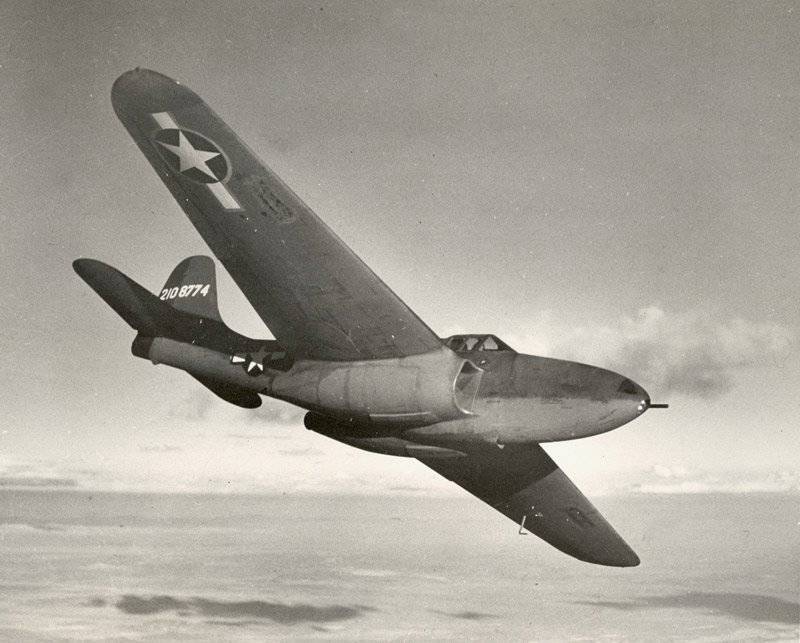
Since June 1943, the Air Force Command and the Bell management have been negotiating the AirAcomet series production. In March, 1944 signed a contract for the construction of the 100 P-59.
The serial P-59A was somewhat different from the experimental machines. They also installed turbojet engines, J31-GE-3 (thrust each 748 kgc), however, reduced the span (to 13,9 meter) and the area (35,86 meter) of the wing. Changed the shape of the rudder making it more square. Below is a profile of improving road stability. Strengthened the design of the fuselage. The flaps and ailerons received duralumin trim. Rack chassis got locks retracted position greater reliability, and the air pressure receiver moved to the keel on top. The maximum speed of the serial machine was 660 km / h. However, the flight characteristics of the P-59A could not exceed the corresponding characteristics of fighters with piston engines. At the same time, attempts were made to increase the engine thrust, to increase the flight range due to the additional amount of fuel located in the two outboard fuel tanks under the wing (capacity of each 250 liters), and some other minor improvements and modifications were made. The machine thus modified was given the designation P-59В.
In the autumn of 1944, the deliveries of the first serial P-59A began, but Airacomet did not last long on the conveyor. The military was disappointed in the new jet fighter, which at first had high hopes. October 10 after the construction of the 39 aircraft serial production stopped.
Since the company had a large reserve of almost finished fuselages and spare parts, they did not destroy them, but assembled several more cars. The total number of serial P-59 was fifty copies, of which 20 was a variant of P-59, 30 - P-59В.
Earlier, the designation XP-59В was assigned to a fighter project equipped with one jet engine and a pair of side air intakes near the fuselage. However, the company "Bell" by that time was already loaded fine-tuning piston "Kingcobra" and "Aerocomet", the development of a single-engine jet fighter was entrusted to the company "Lockheed." According to this scheme, the designers of Lockheed created the famous Shooting Star P-80, which the Soviet pilots met in the skies of Korea.
After the assembly of the car, the shops did not leave immediately - General Electric engineers did not have time to produce a sufficient number of engines. While the assembled planes were waiting in the power plant workshop, a new engine modification was built - J31-GE-5 (thrust 908 kgf). Part of the latest P-59V equipped with these engines.
Five P-59s from 20 collected aircraft were sent to various military research centers: 1 to Wright Field, 2 to Eglin Field, and 2 to Orlando. Another aircraft was sent to Alaska, where it entered a special unit to study the effects of low temperatures on equipment. The turbojet cold turned out to be good, and since December the 1944 car has flown without serious failures around the 70 hours.
15 P-59A joined the four hundred and twelfth fighter group of the fourth command of the Air Force, formed in Murok in November 1943 of the year. This group thus became the first part in the US Air Force to receive jet technology. Soon the group was replenished with ten P-59В having suspended tanks. Another 3 such vehicles for evaluation tests sent to the Navy, and the remaining aircraft of this modification were in reserve or used by the company for various purposes.
The 412-group in July 1945 on the Р-59А and Р-59В flew to California to the base “Santa Maria”, where was the last copy of the YP-59А, which was used as a control plane for radio-controlled aircraft. The group again changes its location in December of 1945 and flies to the March airfield. There, she receives an order to replace her Air-comets with P-80 Shooting Star fighters from Lockheed.
Thus, Bell's first-born jet was in service for only a year, and there was not a single P-1946 left at Marchhe air base in March 59. In Murok, one plane until October 1948 was used for coherent and auxiliary purposes - the machine was given the designation 2.Р-59В. 3 Р-59В, transferred to seamen, survived their brethren for a while. One was written off in December of the 1947 of the year, the other after a rough landing that happened in the same month came into disrepair, and only the third fighter was operated until the end of the 1949 of the year.
The fate of the first jet fighter of the company “Bell” repeated the fate of the first jet machines. All of these aircraft had similar drawbacks — insufficient thrust and unreliable engine performance, difficulty in servicing and low speed. But even despite the fact that the maximum speed of this aircraft was lower than it was planned to receive in the piston fighter, which was the first to receive the designation XP-59A, the jet “Aircomet” in the US military aircraft played its role. The P-59 did not become a full-fledged combat fighter; it served the pilots well, who gained the skills to control jet engines. Operation of the P-59 for designers also became a good school, they tried many technical solutions on the jet first-born Bell.
Performance characteristics of Bell P-59A Airacomet:
Wingspan - 13,87 m;
Wing area - 35,86 m2;
The length of the aircraft - 11,62 m;
The height of the aircraft - 3,65 m;
Empty weight - 3606 kg;
Normal take-off weight - 4909 kg;
Maximum take-off weight - 5902 kg;
Engine - 2 turbojet engine General Electric J31-GE-3 (I-14);
Engine thrust - 2x748 kgf;
Maximum speed at the height of 10670 m - 658 km / h;
Practical range without outboard fuel tanks - 837 km;
Practical range with outboard fuel tanks - 837 km;
Time to climb 9150 m - 15,5 min .;
Practical ceiling - 14090 m;
Armament - two guns of caliber 20 mm (then one gun of M4 caliber 37 mm and three machine guns of caliber 12,7 mm);
Crew - 1 man.
Based on materials:
http://alternathistory.org.ua
http://www.airpages.ru
http://worldofwarplanes.ru
http://aviarmor.net
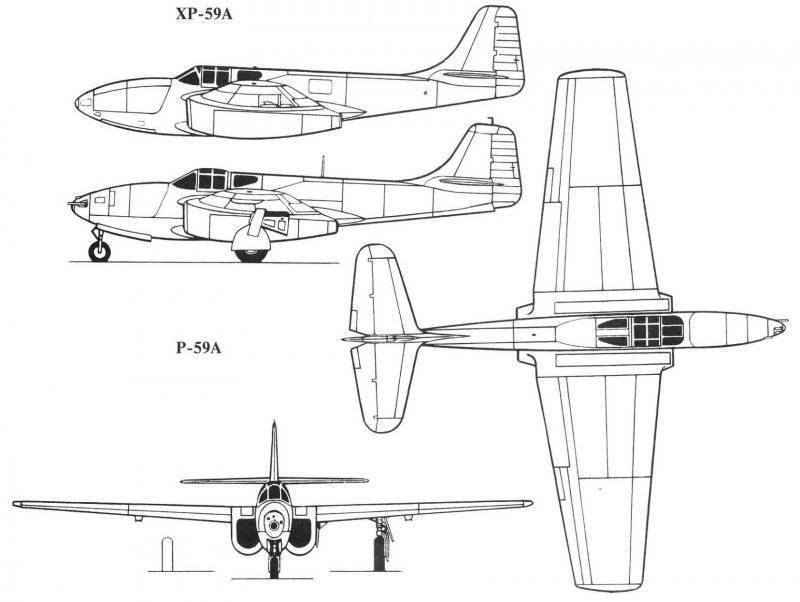
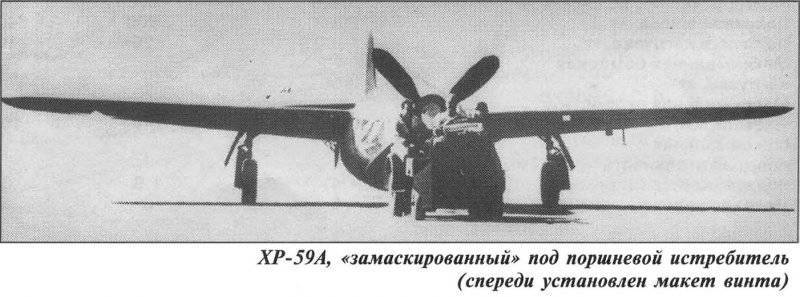
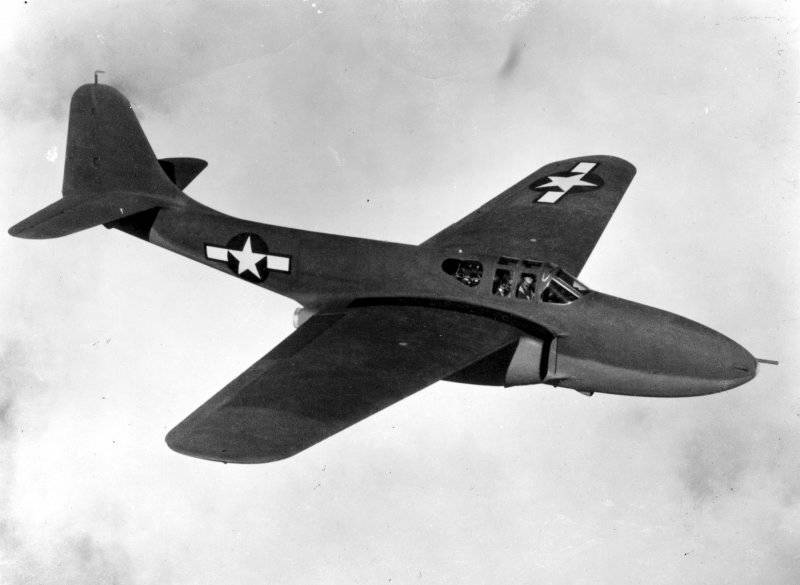
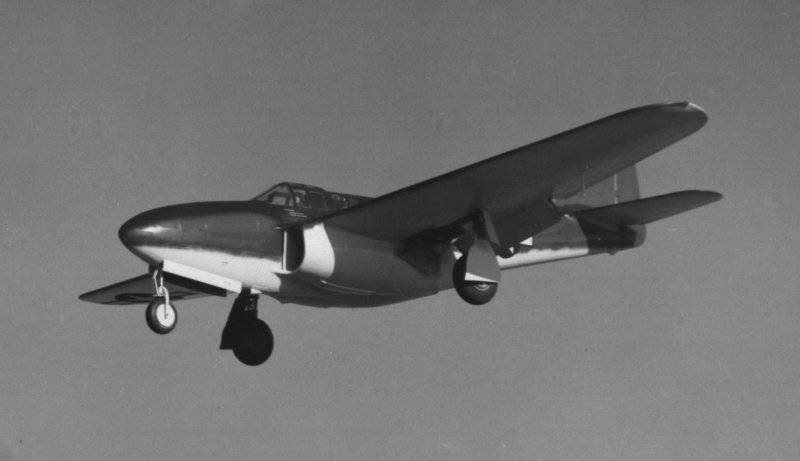
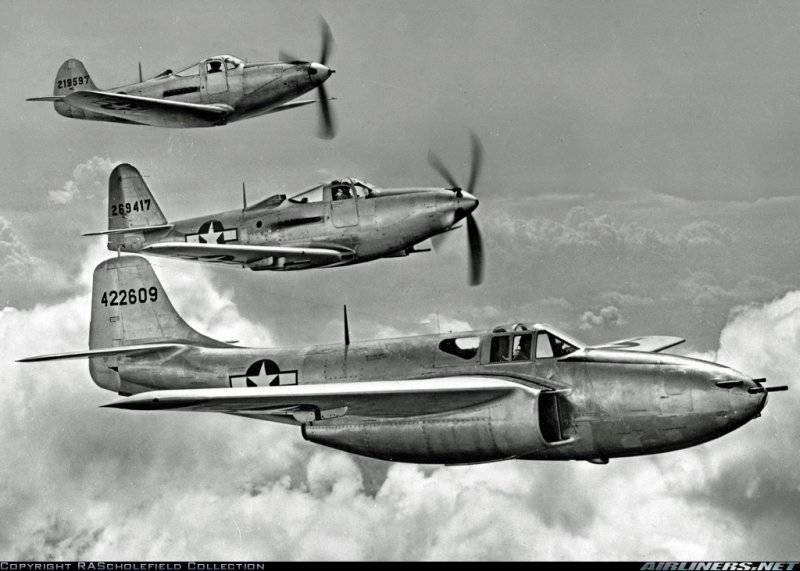
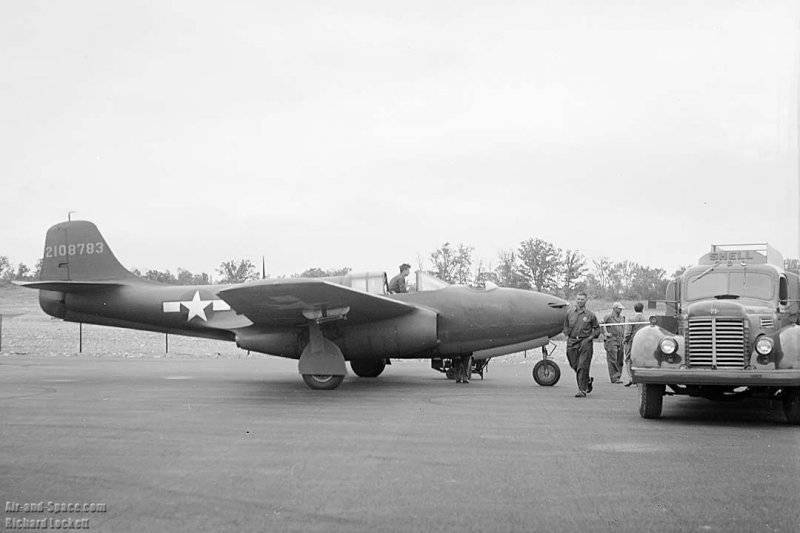
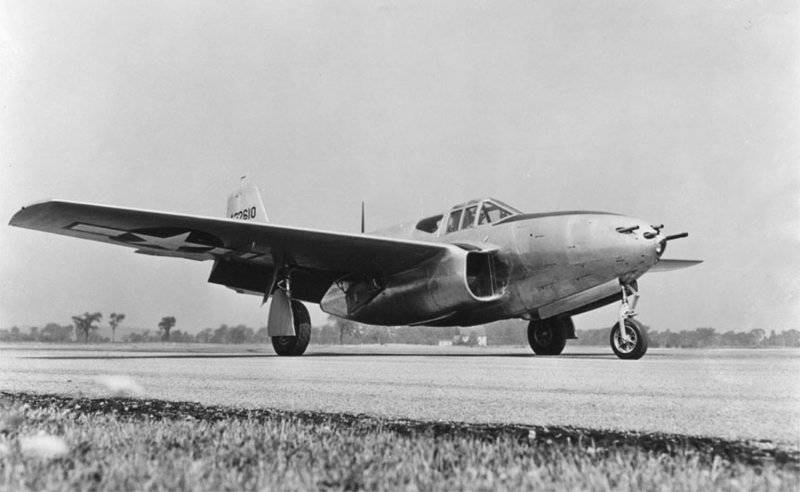
Information